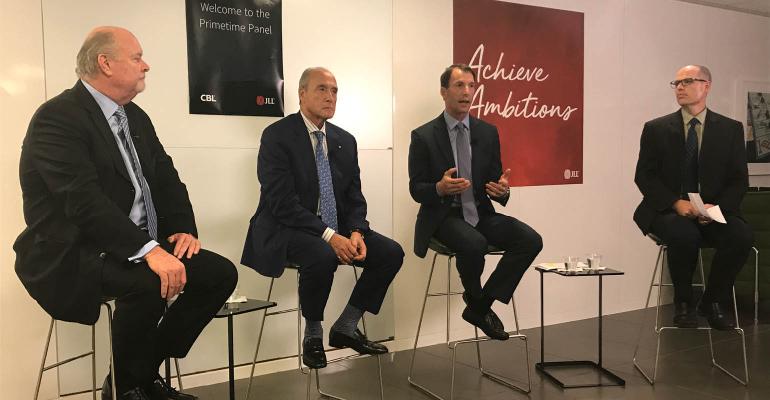JLL hosted a Primetime Panel in New York City on Sept. 28 to discuss the challenges and future of the retail sector with several top-ranking industry executives. Speakers included Stephen Lebovitz, president and CEO of CBL& Associates Properties of Chattanooga, Tenn., Joe Coradino, chairman and CEO of PREIT, and Greg Maloney, president and CEO of JLL’s retail division. Here are some key points from the panel, which was moderated by James Cook, JLL’s director of retail research:
- Technology can help mall owners understand consumers better. Mall executives said they are increasingly relying on technology and social media to help them figure out their customers’ behavior, such as if they are willing to shop after a trip to the gym. Lebovitz said his firm is investing in technology to track these patterns, as there is increased collaboration with retailers to figure out how people like to shop. For example, CBL recently partnered with RetailNext, a camera system that analyzes traffic patterns to different stores and captures information about customers, such as how long they stay at a specific establishment. JLLalso has plans to partner with a company that utilizes geofencing technology—using the GPS system in a cellphone to track people anonymously—to track everything from where a customer goes within a mall to where they go after. “We cannot learn enough about our customers,” Maloney said.
- Alternative uses for excess mall space must be explored. Gyms, hotels, dental offices—everything is on the table in terms of possible tenants, the executives said. Lebovitz, for example, said CBL recently opened a Gold’s Gymat at a property in York, Pa. to absorb excess space. Coradino said adding non-traditional tenants, such as a Whole Foods supermarket or a fitness center, allows for opportunities for cross-shopping. While not every customer will keep shopping after a grocery-store trip, Coradino said the goal is to create a pattern of behavior. “It becomes their space,” he noted. To try to bring in unique retailers, CBL has found success in having temporary pop-up shops for local stores, which helps small businesses generate the foot traffic they’re looking for, according to Lebovitz.
- Be careful with restaurant selection. The executives said adding food options to malls helps bring more people to their properties. But in response to a reporter’s question about the possibility of adding too many chain restaurants—and potentially replicating a harmful, cookie-cutter effect—they acknowledged the importance of researching which restaurants match their consumers’ demands. Coradino said PREIT has added about 25 restaurants to its seven properties over the past couple of years and saw one fail. “We spend a lot of time looking at the restaurant mix, particularly in Philadelphia and D.C., because the competition is intense,” he said. Lebovitz noted that major chain restaurants—such as the Olive Garden—tend to perform best in terms of sales, compared to smaller, local restaurants that could provide a unique draw for the property. CBL will work with regional restaurants that have a good track record to prove they have some staying power, he noted.
- Co-tenancy clauses are “archaic.” Lebovitz said CBL is re-negotiating co-tenancy language in leases with its major tenants, as they previously were written around particular department stores that may have since been replaced. “It’s so archaic that it doesn’t make sense in today’s world at all,” he said. A lot of the negotiations depend on a retailer’s sales and the effect of other uses—like fitness centers—on foot traffic, Lebovitz said.
- In-store shopping remains strong. Countering the myth that brick-and-mortar stores will be obsolete in the near future given the rise of e-commerce, the executives agreed that while there are challenges, there are also opportunities for creative problem-solving and growth. Coradino said there is still demand for retail. Maloney said everyone from baby boomers to their children grew up with shopping centers, and most purchases are done in stores—the change is that consumers expect faster turnover today. Still, physical stores aren’t going anywhere any time soon. “You’re stuck with us,” Lebovitz said. Coradino also noted that department stores are not irrelevant, but Maloney added that, in general, U.S. malls have too much department store space and that it needs to be reduced.
0 comments
Hide comments

